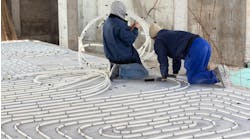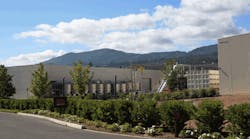Latest from Radiant
eBook: Nelson Mechanical Stories - Volume 1
Sponsored
California’s first LEED Gold winery proves ideal application for radiant cooling
ST. HELENA, CALIF. — When hydronics contractor Robert Reid saw the radiant flooring plan for a commercial winery, he questioned whether the system would work as designed.
The plans for one of Napa Valley’s most prestigious wineries, called for an in-floor Uponor radiant heating and cooling system to precisely control temperatures in two vital production areas: a state-of-the-art, 20,000-sq.ft. winery and a 26,931-sq.ft. barrel cellar. Reid’s concern was that plans specified the radiant tubing be installed at the bottom of the 20-in.-thick concrete slab, instead of sandwiched in-between.
“For most commercial applications, we position the tubing in the top third or middle to ensure a comfortable heat transfer,” said the 33-year plumbing industry veteran and owner of San Rafael, Calif.-based Reid Heating & Energy Inc. “Initially, I was leery about placing the tubing on the bottom of the slab, but I discovered that this lower position made the slab more efficient for this particular application.”
Indeed, the radiant system did perform as planned, and the project’s environmentally friendly construction recently received LEED Gold certification. That recognition made Hall St. Helena the first winery in California to achieve the Gold certification from the U.S. Green Building Council.
This milestone has clearly pleased owners Kathryn and Craig Hall, who first began planning an extraordinary showplace to produce their ultra-premium Bordeaux wines in 2003. Complete with a state-of-the-art production facility and sustainable design technologies, the couple’s long-term mission was to become the leader in earth-friendly California winegrowing.
Attractiveness of radiant
Radiant heating and cooling is a fairly new trend in wineries, acknowledges project engineer Peter Simmonds, Ph.D. with Los Angeles-based IBE Consulting Engineers. Simmonds added that the efficient technology helped achieve the Gold LEED status.
“We explored a range of conventional systems to newer technologies, such as chilled structural beams, but radiant was the only option to deliver the consistent and precise temperature control we required,” said Simmonds, who calls the winery an ideal application for radiant. “Because temperature and humidity have the biggest impact on winemaking, it was vital to design a system that could maintain a consistent 55°F operating temperature. If we got this aspect of the job wrong, the entire project would have been jeopardized.”
Not surprisingly, Hall’s other winery leverages a similar in-floor radiant system to control temperatures and maximize energy and cost efficiencies.
Unique project brings challenges
With radiant technology approved, the design team turned their sights toward overcoming two of the project’s key challenges: maintaining the mandated temperature requirement and accommodating a thick concrete slab.
“Temperature control plays a major role in the winemaking process,” explained Kathryn Hall, who notes that the loss of temperature control can ruin an entire batch of wine and generate a costly loss.
As noted, the winery’s barrel cellar required a 55°F average set temperature, whereas most commercial applications typically want occupants to feel about 20°F warmer. And while the majority of the radiant system’s work is spent cooling the production areas, it is also capable of heating the space so that the ideal temperature is maintained, regardless of the outdoor temperature. A ventilation system provides supplemental cooling and humidity control, as temperatures can vary among the stacks of barrels that extend from the cellar floor to the top of the 25-ft. ceiling.
A Trane water-cooled centrifugal chiller with a cooling tower provides chilled water. Summer design temperature is 102°F. The supply water temperature is 42°F for the barrel cellar and 52°F for other areas. Seven Patterson-Kelley 2,000,000 Btuh boilers can supply heat to the floor, but most of that capacity is actually used for the winemaking process.
The second design challenge was to maintain this unusually cool operating temperature with the tubing buried in nearly 2-ft. of concrete. Reid noted that although typical commercial slabs are between 4- and 6-in. thick, Hall St. Helena’s designers needed a thicker slab to accommodate the weight of the 10,000-gal. stainless steel fermentation tanks. The unusual floor thickness also provided the winery with future production flexibility, so that fermentation tanks can be relocated and secured into the slab with long bolts.
“To protect the radiant tubing from those long anchor bolts, we placed it below even the steel rebar reinforcements — so that any future slab drilling would not interfere with the radiant system,” said project engineer Simmonds. “While the 20-in.-thick slab does take longer to cool, the increased mass is ideal for maintaining the desired temperature.”
Implementing the plan
Installer Reid used roughly 83,000 linear feet of 5/8-in. Wirsbo hePEX tubing for the two buildings.
“Luckily, there were a lot of straight runs without many bends in this project,” recalled Reid, who likens the large warehouse spaces to a football gridiron. “We chose the 5/8-in. hePEX because we could sustain runs up to 500-ft. per loop with the larger diameter. With 1/2-in. tube, we couldn’t really exceed 320-ft. per run.”
Reid and his crew began the installation process by stapling the PEX tubing to sheets of 2-in. rigid insulation at roughly 6-in. on center.
“Obviously, with spacing so tight, we had to stagger turns and flair out the tubing before making a turn,” he said.
With nearly 200 loops at an average of 490-ft., Reid’s football field analogy wasn’t far off the mark. The PEX tubing was routed to 14 manifolds that provide control for the two buildings. Once a section was stapled, a rebar mesh was laid on top of the tubing to provide support for the substantial slab floor.
“We left the tubing under about 100-PSI of water pressure during the rebar installation and concrete pour, so we could immediately identify and replace any portion that was inadvertently punctured,” explained Reid.
All in all, he said, the project was very unique and memorable.
“Although we do hundreds of commercial radiant installations a year, only one or two involve cooling — and nothing on the scale of this project,” concluded Reid. “Hall St. Helena was unique for its unconventional ‘cool’ temperature, thick foundation and the sheer size of the warehouse buildings.”
According to the project’s owners, the radiant system has exceeded expectations.
“Green building technologies such as radiant, have always been an important part of who we are and what we do,” said Kathryn Hall. “Aside from achieving energy efficiency, the radiant system allows our winemaking team to maintain precise control of the temperature inside our new buildings, which is vital to ensuring the quality of our award-winning wines.”
Sustainable design features
To meet the precise requirements to become Gold LEED certified, planners of the Hall St. Helena winery incorporated many sustainable design elements and practices including:
Radiant Floors – Radiant flooring allows Hall to control the facility’s temperature while conserving energy and providing a stable storage and production environment.
Solar Energy – The sun provides more than 35% of the energy needed to power Hall St. Helena. Solar photovoltaic cells on the roofs of the barrel cellar and fermentation building convert sunlight into electricity. Approximately 42,000-sq.ft. of solar panels span the winery roofs.
Local Building Materials – More than 10% of materials used to build the facility were extracted, harvested or recovered, as well as manufactured, within 500 miles of the project site.
Recycled Building Materials – More than 10% of the materials used were made with recycled content.
Water Conservation – Drought-tolerant plant species selected for the winery landscaping will reduce the demand for irrigation by more than 50%. All of the landscaping and vineyards are irrigated with recycled water. A 40% reduction of building water has also been achieved through the use of low-flow plumbing fixtures.
Joel Williams is a Chicago-based freelance writer.


